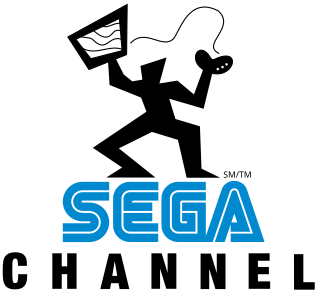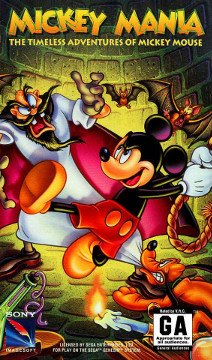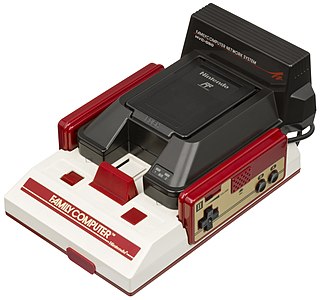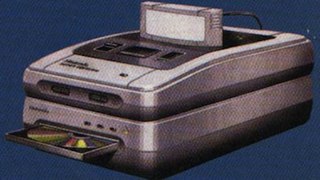
The Super Nintendo Entertainment System, commonly shortened to Super Nintendo, Super NES or SNES, is a 16-bit home video game console developed by Nintendo that was released in 1990 in Japan and South Korea, 1991 in North America, 1992 in Europe and Oceania, and 1993 in South America. In Japan, it is called the Super Famicom (SFC). In South Korea, it is called the Super Comboy and was distributed by Hyundai Electronics. The system was released in Brazil on August 30, 1993, by Playtronic. Although each version is essentially the same, several forms of regional lockout prevent cartridges for one version from being used in other versions.

Earthworm Jim is a 1994 run and gun platform game developed by Shiny Entertainment, featuring an earthworm named Jim, who wears a robotic suit and battles the forces of evil. The game was released for the Sega Genesis and Super Nintendo Entertainment System, before being subsequently ported to a number of other video game consoles.
GameLine was a dialup game distribution service for the Atari 2600, developed and operated by Control Video Corporation. Subscribers could install the proprietary modem and storage cartridge in their home game console, accessing the GameLine service to download games over a telephone line. GameLine had an exclusive selection of games, and its pioneering business model eventually gave rise to America Online. Despite being ahead of its time, it wasn't very popular, possibly due to its price of $60 for the hardware, $15 for the membership fee, and $1 per game, which you could only keep for a week.
Sega Meganet, also known as the Net Work System, was an online service for the Mega Drive in Japan and later Brazil. Utilizing dial-up Internet access, Meganet was Sega's first online multiplayer gaming service, and functioned on a pay to play basis. The system functioned through the use of a peripheral called the Mega Modem and offered several unique titles that could be downloaded, and a few could be played competitively with friends. In addition, it shared technology and equipment with more serious services such as the Mega Anser, used for banking purposes. Though the system was announced for North America under the rebranded name "Tele-Genesis", it was never released for that region. Ultimately, the Meganet service would be short-lived, lasting approximately a year before it was discontinued, but would serve as a precursor to the Sega Channel and XBAND services, as well as a predecessor to online gaming services for video game consoles. Retrospective feedback praises the attempt by Sega to introduce online gaming, but criticizes the service for its logistical issues and lack of titles.

In the history of video games, the third generation of video game consoles, commonly referred to as the 8-bit era, began on July 15, 1983, with the Japanese release of two systems: Nintendo's Family Computer and Sega's SG-1000. When the Famicom was not released outside of Japan, it was remodeled and marketed as the Nintendo Entertainment System (NES). This generation marked the end of the video game crash of 1983, and a shift in the dominance of home video game manufacturers from the United States to Japan. Handheld consoles were not a major part of this generation; the Game & Watch line from Nintendo and the Milton Bradley Microvision that were sold at the time are both considered part of the previous generation due to hardware typical of the second generation.

The Super FX is a coprocessor on the Graphics Support Unit (GSU) added to select Super Nintendo Entertainment System (SNES) video game cartridges, primarily to facilitate advanced 2D and 3D graphics. The Super FX chip was designed by Argonaut Games, who also co-developed the 3D space rail shooter video game Star Fox with Nintendo to demonstrate the additional polygon rendering capabilities that the chip had introduced to the SNES.

The history of the Nintendo Entertainment System (NES) spans the 1982 development of the Family Computer, to the 1985 launch of the NES, to Nintendo's rise to global dominance based upon this platform throughout the late 1980s. The Family Computer or Famicom was developed in 1982 and launched in 1983 in Japan. Following the North American video game crash of 1983, the Famicom was adapted into the NES which was brazenly launched in North America in 1985. Transitioning the company from its arcade game history into this combined global 8-bit home video game console platform, the Famicom and NES continued to aggressively compete with the next-generation 16-bit consoles including the 1988 Sega Genesis. The platform was succeeded by the Super Famicom in 1990 and the Super Nintendo Entertainment System in 1991, but its support and production continued until 1995. Interest in the NES has been renewed by collectors and emulators, including Nintendo's own Virtual Console platform.

The Sega Channel is a discontinued online game service developed by Sega for the Sega Genesis video game console, serving as a content delivery system. Launched on December 14, 1994, the Sega Channel was provided to the public by TCI and Time Warner Cable through cable television services by way of coaxial cable. It was a pay to play service, through which customers could access Genesis games online, play game demos, and get cheat codes. Lasting until July 31, 1998, the Sega Channel operated three years after the release of Sega's next generation console, the Sega Saturn. Though criticized for its poorly timed launch and high subscription fee, the Sega Channel has been praised for its innovations in downloadable content and impact on online game services.
XBAND was one of the first competitive online console gaming networks and was available for the Genesis and Super NES. It was produced by Catapult Entertainment in Cupertino, California. It is the only modem released in America to have been officially licensed by Nintendo. It debuted in various areas of the United States between November 1994 and June 1995 and was later released nationwide between October 2 and 8, 1995.

The Genesis, also known as the Mega Drive outside North America, is a 16-bit fourth generation home video game console developed and sold by Sega. It was Sega's third console and the successor to the Master System. Sega released it in 1988 in Japan as the Mega Drive, and in 1989 in North America as the Genesis. In 1990, it was distributed as the Mega Drive by Virgin Mastertronic in Europe, Ozisoft in Australasia, and Tectoy in Brazil. In South Korea, it was distributed by Samsung Electronics as the Super Gam*Boy and later the Super Aladdin Boy.

Mickey Mania: The Timeless Adventures of Mickey Mouse is a 1994 platform video game developed by Traveller's Tales and published by Sony Imagesoft for the Super NES, Sega Genesis, and Sega CD. In the game, the player controls Mickey Mouse, who must navigate through various side-scrolling levels, each designed and based on classical Mickey Mouse cartoons. The game was later released on the PlayStation in 1996 as Mickey's Wild Adventure in PAL regions by Sony Computer Entertainment, Sony Imagesoft's successor. A second game, Mickey Mania 2, was intended to be released but was cancelled due to Traveller's Tales focusing on other games.
Stephen G. "Steve" Perlman is an entrepreneur and inventor of Internet, entertainment, multimedia, consumer electronics and communications technologies and services. He is best known for the development of QuickTime, WebTV, OnLive, pCell and Mova Contour facial capture technologies. In addition to founding startup companies, Perlman was a Microsoft division president and a principal scientist at Apple Computer.

The Family Computer Network System, also known as the Famicom Net System and Famicom Modem, is a peripheral for Nintendo's Family Computer video game console, and was released in September 1988 only in Japan. Predating the modern Internet, its proprietary dial-up information service accessed live stock trades, video game cheats, jokes, weather forecasts, betting on horse racing, and a small amount of downloadable content. The device uses a ROM card storage format, reminiscent to the HuCard for the TurboGrafx-16 and the Sega Card for the Master System.

Higan is a free and open source emulator for multiple video game consoles, including the Super Nintendo Entertainment System. Originally called bsnes, the emulator is notable for attempting to emulate the original hardware as accurately as possible through low-level, cycle-accurate emulation and for the associated historical preservation efforts of the Super NES platform.

The Nintendo Entertainment System (NES) is an 8-bit third-generation home video game console produced by Nintendo. It was first released in Japan in 1983 as the Family Computer (FC), commonly referred to as Famicom. It was redesigned to become the NES, which was released in American test markets on October 18, 1985, and was soon fully launched in North America and other countries.
Online console gaming involves connecting a console to a network over the Internet for services. Through this connection, it provides users the ability to play games with other users online, in addition to other online services.

The Super NES CD-ROM, internally known as the Super NES CD-Rom System in the West and as the Super Famicom CD-ROM Adapter in Japan, is an unreleased add-on for the Super Nintendo Entertainment System (SNES) video game console. Commonly known as the SNES-CD, it was built upon the functionality of the cartridge-based SNES by adding support for a CD-ROM-based format known as Super Disc.
In the video game industry, a console war describes the competition between two or more video game console manufacturers in trying to achieve better consumer sales through more advanced console technology, an improved selection of video games, and general marketing around their consoles. While console manufacturers are generally always trying to out-perform other manufacturers in sales, these console wars engage in more direct tactics to compare their offerings directly against their competitors or to disparage the competition in contrast to their own, and thus the marketing efforts have tended to escalate in back-and-forth pushes.

In the video game industry, the market for home video game consoles has frequently been segmented into generations, grouping consoles that are considered to have shared in a competitive marketspace. Since the first home consoles in 1972, there have been nine defined home console generations.











